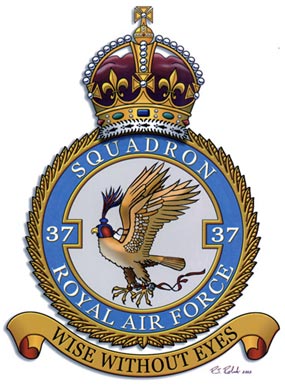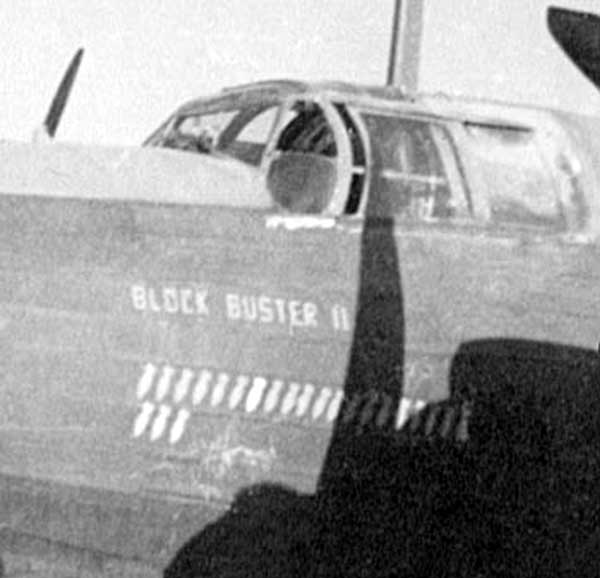OP 21 - SZEKESFEHERVAR MARSHALLING YARDS
As the Soviet army continued to press the eastern front steadily westward, German forces began to evacuate troops and material from the rapidly advancing front. To thwart these movements, an intensive daylight bombing campaign was waged by the 15th Air Force against the rail system between Budapest and Vienna. By October 13, 1944, the rail lines through Szekesfehervar, Hungary were the only open route between Budapest and Vienna remaining. The object of the attack on the night of October 13/14, 1944 was to destroy all rolling stock in the marshalling yards and to sever the through tracks. Sixteen Wellingtons of No. 37 Squadron participated in the attack from a total of eighty two 205 Group aircraft detailed for this operation.
W/O MacIsaac and his crew set out for Hungary carrying nine 500 pound bombs, two 250 pound bombs and four packets of nickels. They flew in their usual aircraft, Wellington Mk.X LN978 "D". "Block Buster II" left the PSP strip at Tortorella at 1723 hours - it was the last time that LN798 "D" would ever take to the air.
The weather was clear over the target, but there was a slight ground haze obscuring the view of the yards. The incoming bomber stream was met with heavy and light caliber flak - mostly inaccurate.
Green target indicators were dropped on the northern edge of the center of the yards and the Squadron attacked on these, dropping one 4000 pound bomb, one hundred twenty six 500 pound bombs, thirty eight 250 pound bombs and ninety five packets of leaflets at 2010 to 2015½ hours from altitudes of 6700 to 8000 feet. Bombing was reported by all crews as well concentrated on the green TI’s, and after leaving the target area fires were visible up to 100 miles away.
Two aircraft of No. 205 Group were shot down over the target with the loss of both crews.
Flak continued to be an obstacle on the return leg of the operation. Roughly 30 miles south of the Drave River, at 2101 hours, W/O MacIsaac was hit by a heavy caliber flak shell that exploded near the tail of Wellington "D". The burst did severe damage to the planes rudder, elevator and rear underside of the fuselage - amazingly the rear gunner escaped injury.
 Wellington Mk.X MF244 of 205 Groups No 150 Squadron showing damage very similar to that suffered by LN798 "D" on the night of October 13/14 over Szekesfehervar. |
Despite the heavy damage, the crew did not bale out and MacIsaac managed to bring his bomber home and land safely at 2255 hours - his second adventure bringing a crippled Wellington home without loss. Both incidents testify not only to his skill as a pilot, but the legendary endurance of the Wimpys unique construction. Unfortunately, the damage done to the airframe was such that LN798 "D" was judged to be beyond repair, and was torn up for spare parts.
|
|
Photo reconnaissance of October 14 showed that all the through lines at Szekesfehervar had been cut, that the marshalling yards were effectively blocked by destroyed rail cars, and that serious damage was done to yard installations including the roundhouse and a large repair shop. The success of the operation was added to by a daylight mission flown immediately afterward by the 15th Air Force.
* * *
From the 37 Squadron ORB, October 15, 1944:
DOMESTIC ARRANGEMENTS - On this and the preceding day approximately 120 airmen arrived on the unit of 142 and 150 Squadrons on the disbandment of those units. These men were posted in against the anticipated increased establishment for the conversion of the Squadron to heavy bomber status with Liberator aircraft. Although the arrival of this considerable number had of course been anticipated, nevertheless considerable problems arose out of the lack of accommodation and domestic equipment. Equipment sources were pressed to deliver forthwith adequate supplies of such items as blankets, hurricane lamps, rubber knee boots, etc., and before the close of the day all essential items had been made available. It became apparent at once that the airmens mess and canteen would need to be further extended and as a temporary measure it was decided to add two E.P.I.P. tents to the end of the building comprising the mess.



